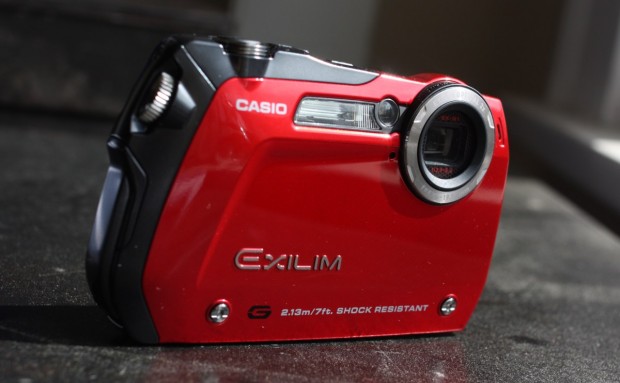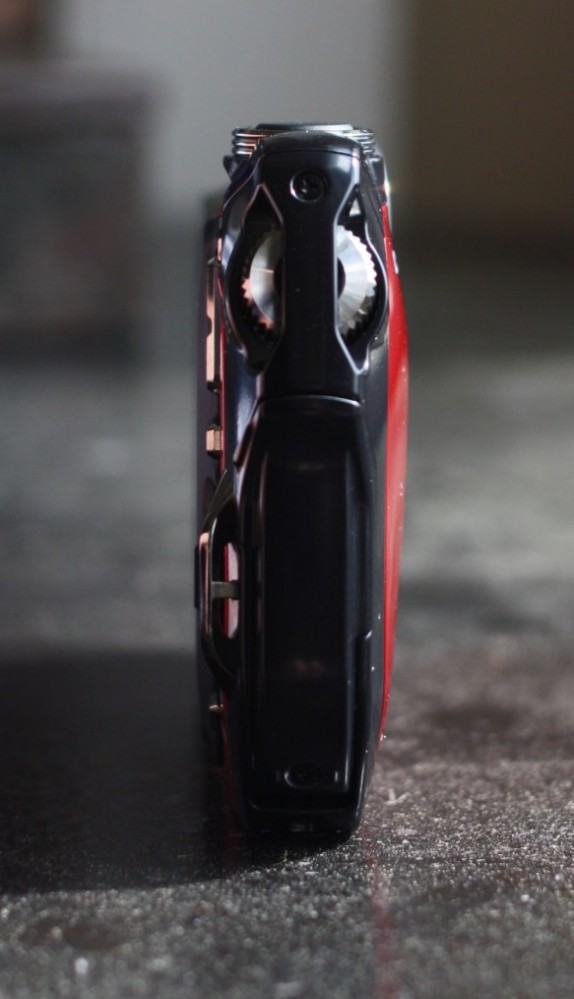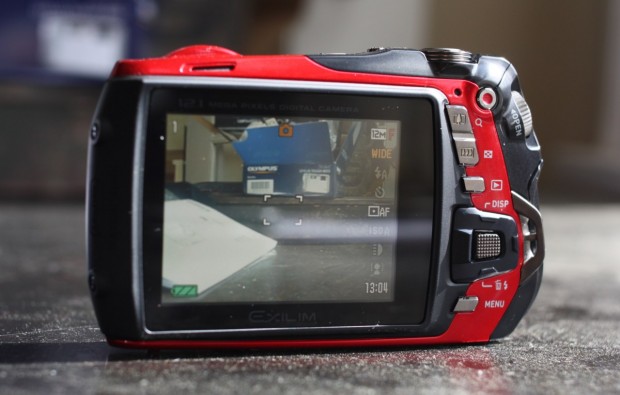
Short version: The coolest-looking and slimmest camera in our roundup may also be your best bet. If only it had better video, the EX-G1 would be the best choice by far. As it is, it still gets my recommendation.
Features:
- 12.1 megapixels
- 3x optical zoom
- Waterproof (3m/10ft), shockproof (7ft), dustproof (dust)
- Slim design
- MSRP: $300
Pros:
- Layout and build quality are excellent
- Image quality is great
- Slim and sexy
Cons:
- No HD video (no high-speed for that matter, come on Casio!)
- Extra fiddly bits are easy to lose
- Twist-to-open SD and port cover not the most secure
Full review:
I was surprised when I saw this camera announced. I mean, it’s nice to put out a rugged camera, and the EX-G1 looked nice, but Casio has a leg up on the rest of the industry with its high speed sensor tricks, and if they could have put that into this thing (plus 720p video), I would have declared it the winner sight unseen. But as it is, the camera has neither HD nor high speed video, hoping instead that its slim body and pretty design will set it apart. And so they do.
This little guy performed just fine in my tests, although for some reason its underwater pictures turned out badly. I’m not holding that against it, though, since it was mainly fish placement issues.
 The EX-G1 is the best-looking and slimmest camera in our roundup, though it’s as much a psychological distinction as a physical one. Right next to the brick-like Olympus, it’s only a few mm slimmer and actually slightly wider end-to-end. Its funky shape and tapered edges, however, make it feel a lot smaller, and it seems to go more naturally into a pocket than the Stylus 8010 or even the relatively compact Fuji.
The EX-G1 is the best-looking and slimmest camera in our roundup, though it’s as much a psychological distinction as a physical one. Right next to the brick-like Olympus, it’s only a few mm slimmer and actually slightly wider end-to-end. Its funky shape and tapered edges, however, make it feel a lot smaller, and it seems to go more naturally into a pocket than the Stylus 8010 or even the relatively compact Fuji.
But Casio giveth, and Casio taketh away. The EX-G1 is the only camera in the roundup that doesn’t shoot in 720p or better. I mean, given the quality of 1080p video on the Playsport, that’s not necessarily a bad thing, but if you like working in 720p so you can put it right up on your TV with no stretching or reprocessing, this is definitely a minus. The 848×480 widescreen video isn’t bad, but it’s about the same quality as the HD on the other cameras. This is really the main point against the camera: if you need or really want HD, even crappy HD as most cameras these days have, then the EX-G1 is not for you.
Here’s a still from the underwater footage shot for the above video. Lots of chroma noise, as you can see:
Interestingly, though, I found that the Casio had the best still image quality of the three cameras. It’s a little bit over-sharpened and the white balance is different from the Fuji and Olympus, but there’s a lot of detail, the exposure is good, and Casio’s “Best Shot” modes are occasionally useful. In shooting up close (nearly macro) the Casio was far and away the winner (Casio, Olympus, Fujifilm) — I suspect with a little tweaking in Program mode I could have made the others a little better, but they were set to macro/close-up and in good light; I think the results are admissible. You can also see the clarity of the Casio’s shots if you look at the full-size centers of the building and cherry tree (in this set); there’s more fine detail and I feel the color is more accurate.
The Casio also sports a little triple-LED recording light, which is pretty awesome. It’d be nice to have a hardware on/off switch, but it’s easy enough to do in the quick-access menu and really, cameras have enough buttons already. It’s not particularly bright, but it could be the difference between picture and no picture underwater or at a party. Probably helps with AF, too.
The layout and ergonomics of the EX-G1 were my favorite by far. The Fujifilm’s buttons were mushy and hard to press, and the Olympus, while simply and functionally laid out, were not nearly as intuitive or accessible as Casio’s. The separate still and movie buttons press easily, the raised D-pad is clicky and would be easy to operate even with numb fingers, and I never once hit a button by mistake or had trouble getting one to recognize that it was being pressed.
The I/O ports are reached by twisting a little dial, which is clever except that you only have to turn the dial like 20 degrees before it opens. Since it’s up near the shutter buttons, I foresee a few accidental openings in this camera’s future. There are also a few extra items that come with the camera: little bumpers for the left side, which you attach with microscopic screws. I’m thinking they’re probably mostly ornamental, and they end up making the camera a little bigger anyway. And there’s a little doodad that you’re supposed to keep on the lanyard which you can use (though it’s not required) to open the battery compartment. I see that thing lasting about a month. It seems like these little extra plastic bits were ideas Casio brainstormed early on but couldn’t come to an agreement about which to implement and how — so you’re stuck with a couple little baggies and some screws you’ll be puzzling over in five years. “What are these things for?”
The quick menu is handy for switching modes, though I question some of the additions — “Make-up” and “Vibrant landscape” are two modes that you can switch on and off which probably could have stayed buried in the menus somewhere, as they just clutter up the main screen. But the LED controls are there, as well as movie format, AF mode, and all the stuff you need to adjust quickly for various situations.
The Best Shot mode, as I noted, is occasionally useful. Modes like “Pet” and “Sunset” I can do without, but it has a time-lapse feature and a “pre-record” mode that lets you capture the last few seconds of video when you hit the movie capture button. Handy stuff, though not as versatile as the non-rugged Exilims.
Interestingly, the EX-G1 uses MicroSD instead of regular SD. It’s not really a problem at all, but of course a MicroSD adapter is one more little thing to carry around. Capacity is a concern if you never unload your camera, but hey, there are 32GB MicroSD cards now, and I’m still rocking 4GB on my DSLR. I don’t think it’ll really be an issue.
Conclusion
Although it’s a bit of a spoiler for tomorrow’s Olympus review, I’m going to go ahead and say that the EX-G1 is my pick for this roundup. It’s more compact than the others, takes great pictures, has some handy extra features, and it’s cool-looking to boot. The lack of HD video may be a deal-breaker for some, but those who can see past the numbers will know that the quality of the 720p on cameras like this is no great shakes, and 848×480 is sufficient for scuba diving videos. Now Casio, get started on a slow-mo-capable version of this thing!










